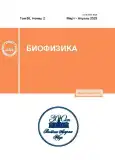Prediction of metabolic activity of rowing athletes based on serum biochemical analysis
- Авторлар: Pustovoyt V.I1, Astrelina T.A1, Balakin E.I1, Kobzeva I.V1, Suchkova Y.B1, Khan A.V1, Murtazin A.A1, Maksjutov N.F1, Brumberg V.A1
-
Мекемелер:
- State Research Center - Burnasyan Federal Medical Biophysical Center, Federal Medical Biological Agency
- Шығарылым: Том 68, № 2 (2023)
- Беттер: 396-403
- Бөлім: Articles
- URL: https://journals.rcsi.science/0006-3029/article/view/144438
- DOI: https://doi.org/10.31857/S0006302923020205
- EDN: https://elibrary.ru/CDMJII
- ID: 144438
Дәйексөз келтіру
Толық мәтін
Аннотация
Негізгі сөздер
Авторлар туралы
V. Pustovoyt
State Research Center - Burnasyan Federal Medical Biophysical Center, Federal Medical Biological Agency
Email: vpust@yandex.ru
Moscow, Russia
T. Astrelina
State Research Center - Burnasyan Federal Medical Biophysical Center, Federal Medical Biological AgencyMoscow, Russia
E. Balakin
State Research Center - Burnasyan Federal Medical Biophysical Center, Federal Medical Biological AgencyMoscow, Russia
I. Kobzeva
State Research Center - Burnasyan Federal Medical Biophysical Center, Federal Medical Biological AgencyMoscow, Russia
Y. Suchkova
State Research Center - Burnasyan Federal Medical Biophysical Center, Federal Medical Biological AgencyMoscow, Russia
A. Khan
State Research Center - Burnasyan Federal Medical Biophysical Center, Federal Medical Biological AgencyMoscow, Russia
A. Murtazin
State Research Center - Burnasyan Federal Medical Biophysical Center, Federal Medical Biological AgencyMoscow, Russia
N. Maksjutov
State Research Center - Burnasyan Federal Medical Biophysical Center, Federal Medical Biological AgencyMoscow, Russia
V. Brumberg
State Research Center - Burnasyan Federal Medical Biophysical Center, Federal Medical Biological AgencyMoscow, Russia
Әдебиет тізімі
- G. Banfi, A. Colombini, G. Lombardi, and A. Lubkowska, Adv. Clin. Chem., 56, 1 (2012).
- P. Brancaccio, N. Maffulli, and F. M. Limongelli, Br. Med. Bull., 81-82, 209 (2007).
- S. Honda, T. Kawasaki, T. Kamitani, and K. Kiyota, Intern. Med. Tokyo Jpn., 56, 1175 (2017).
- F. Hoppel, E. Calabria, D. Pesta, et al., Front. Physiol., 10, 1300 (2019).
- D. Magrini, M. Khodaee, I. San-Millán, et al., Phys. Sportsmed., 45, 129 (2017).
- J. Á. Rubio-Arias, V. Ávila-Gandía, F. J. López-Román, et al., Physiol. Behav., 205, 51 (2019).
- A. J. Siegel, L. M. Silverman, and R. E. Lopez, Yale J. Biol. Med., 53, 275 (1980).
- J. N. Tirabassi, L. Olewinski, and M. Khodaee, Sports Health, 10, 361 (2018).
- T. Chamera, M. Spieszny, T. Klocek, et al., J. Strength Cond. Res., 28, 2180 (2014).
- G. Lippi, F. Schena, M. Montagnana, et al., Eur. J. Intern. Med., 22, e36 (2011).
- J. Mieszkowski, B. E. Stankiewicz, A. Kochanowicz, et al., Front. Physiol., 12, 731889 (2021).
- A. Nowakowska, D. Kostrzewa-Nowak, R. Buryta, and R. Nowak, Int. J. Environ. Res. Public. Health, 16, 3279 (2019).
- K.-A. Shin, K. D. Park, J. Ahn, et al., Medicine (Baltimore), 95, e3657 (2016).
- H.-J. Wu, K.-T. Chen, B.-W. Shee, et al., World J. Gastroenterol., 10, 2711 (2004).
- G. Banfi, G. Lombardi, A. Colombini, and G. Lippi, Sports Med. Auckl. NZ, 40, 697 (2010).
- O. A. Ekun, A. F. Emiabata, O. C. Abiodun, et al., BMJ Open Sport Exerc. Med., 3, e000223 (2017).
- F. Hoppel, E. Calabria, D. H. Pesta, et al., Front. Physiol., 12, 632664 (2021).
- L. A. Juett, K. L. Midwood, M. P. Funnell, et al., Eur. J. Appl. Physiol., 121, 3485 (2021).
- M. Lecina, I. López, C. Castellar, and F. Pradas, Int. J. Environ. Res. Public. Health, 18, 11323 (2021).
- M. P. G. Leers, R. Schepers, and R. Baumgarten, Clin. Chem. Lab. Med., 44, 999 (2006).
- A. Colombini, M. Machado, G. Lombardi, et al., J. Sports Med. Phys. Fitness, 54, 658 (2014).
- G. Banfi, M. Del Fabbro, and G. Lippi, Br. J. Sports Med., 40, 675 (2006).
- R. Milić, G. Banfi, M. Del Fabbro, and M. Dopsaj, Clin. Chem. Lab. Med., 49, 285 (2011).
- В. И. Пустовойт, Р. В. Никонов, А. С. Самойлов и др., Курортная медицина, № 2, 85 (2021).
- http://statsoft.ru/home/textbook/default.htm.
Қосымша файлдар









